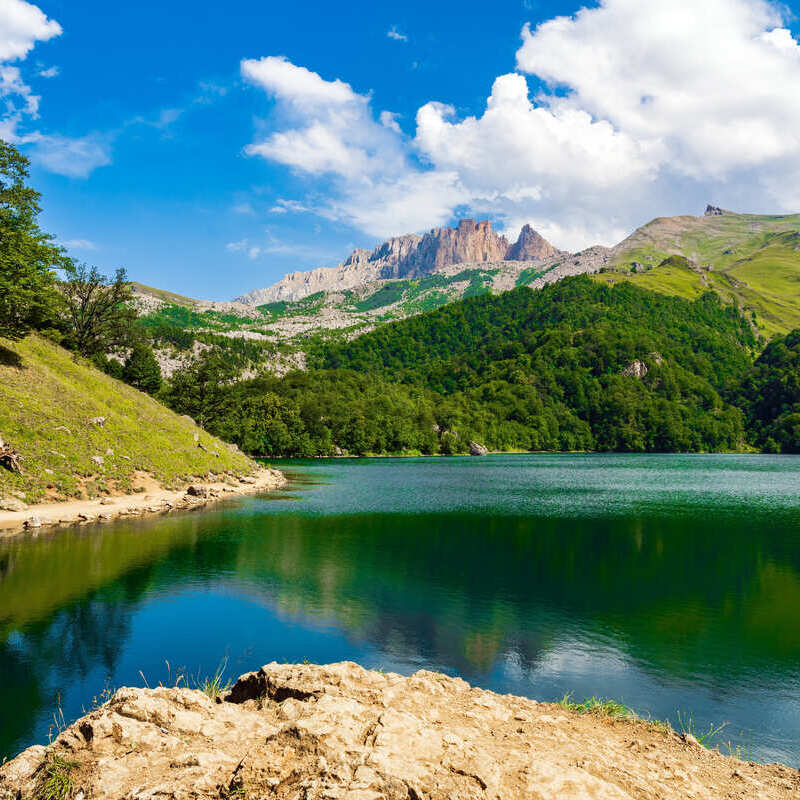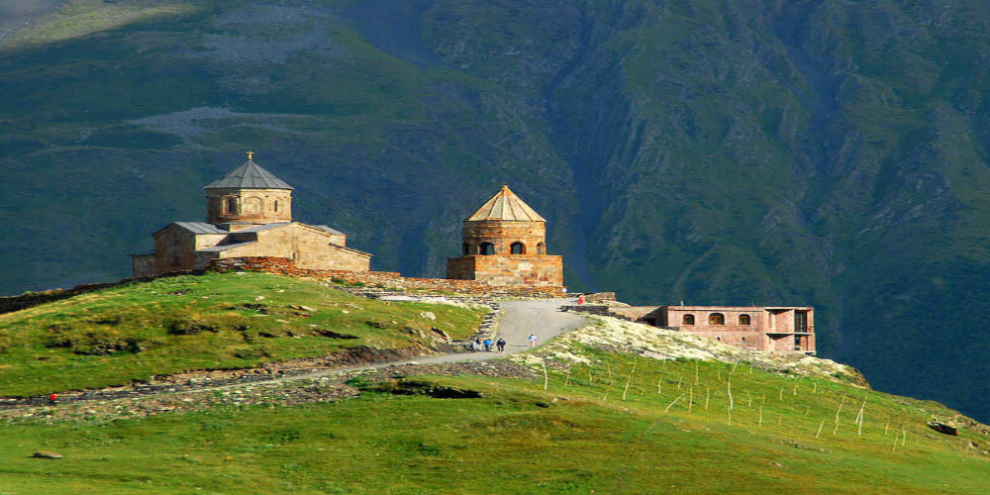Eastern Europe is awash with tourists now that border curbs have been lifted, and the off-path travel trend is gaining traction.
A historically overlooked region, it is now deemed a promising destination, being favored by budget-conscious, culture-seeking travelers.
Despite the sudden popularity the bloc is enjoying, particularly the Balkan Peninsula, home to the likes of Croatia, Albania, and Montenegro, there are other lesser-known spots in the East, or dare we say, the Far East, that are still not getting their flowers, and are perhaps Eastern Europe’s most underrated region.
Farther away from the European mainland lies a mysterious territory dotted with ancient castles, graced with an otherworldly nature and with an intriguing history dating back several millennia:
Welcome To The Cross-Continental Caucasus

The Caucasus is a cross-continental region straddling the intersection dividing Eastern Europe and Asia, defined as the Caucasus mountain range.
Ambiguous in nature, it exists ‘in between’ both continents, comprising three countries closely linked through geography and History:
- Armenia
- Azerbaijan
- Georgia
These three countries are variously described as European, Asian, or the less-contentious term ‘Caucasian’, and though all definitions are true, self-identification is often indicative of an individual’s political inclinations, whether they favor stronger ties to the West or not.
Let’s find out how exactly they differ from one another, what are some of the main cultural traits, and what each country can offer potential visitors:
Armenia
The First People To Have Converted To Christianity
Armenians were the first people to convert to Christianity at the turn of the last millennia, abandoning the Greco-Roman gods and other deities of the time that would later be considered pagan.
They take a lot of pride in that, as well as in being one of the most ancient nations in the world.
Armenia’s History can be traced back to the 7th century BC, and some of the oldest and best-preserved Roman and early Christian monuments can be found here, such as the Hellenic Temple of Garni, and the Etchmiadzin Cathedral, the first to have ever been built.

Throughout the centuries, the country’s character was shaped by the many different empires and global powers which conquered, annexed, or incorporated parts of it, from the Persians to the Russians.
During the 20th century, it inched ever closer to Moscow’s communist ideology.
Modern-day Armenia is an independent state, though the influence of external forces, particularly Russia, is evident in law-making, architecture, cuisine, and daily life.
As a visitor, you should expect a unique blend of ancient and Soviet, welcoming locals, numberless Orthodox churches, and crowd-free tourist sites.

Top Things To See In Armenia
- Yerevan, the country’s capital, famous for its Soviet-era Cascade Complex and state-of-the-art museums
- Sevan, a scenic lake and largest body of water in the Caucasus housing a 9th-century monastery
- Dilijan, a small cobblestone town offering easy access to forested reserves, natural springs, and mountain retreats, dubbed the ‘Armenian Switzerland’
- Geghard, a UNESCO World Heritage Site and medieval monastic complex nestled in the rugged mountains of Eastern Armenia
- Garni, a Greco-Roman temple built in the 1st century AD, once the only-standing building of its kind in the former Soviet Union
- Khor Virap, yet another monastery set against the dramatic backdrop of Mount Ararat, close to the border with Turkiye
Azerbaijan
The Odd One Out
Azerbaijan is the only Muslim-majority country in the Caucasus, and an ethnically-Turkic state boasting an extensive Caspian Sea coastline, dramatic landscapes, monasteries, and a fast-developing, futuristic capital where clusters of skyscrapers coexist with medieval monuments.
American tourists are granted a 30-day e-Visa to explore the country, more than enough time to immerse themselves in the culture, sample the meat-heavy, Middle Eastern-inspired cuisine, stroll the lively streets of Baku, and explore the bucolic countryside.

Although the Azerbaijani language is closely related to Turkish, with a certain degree of mutual intelligibility, and Azerbaijanis themselves do not shy away from its Turkic origins, the nationhood was strongly affected by Russian control during the USSR.
Today, Azerbaijan is perhaps the least-free state of the Caucasus, still closely aligned politically with the Kremlin in spite of the dissolution of the Soviet Union, but unlike Russia, it is open for tourism and eager to welcome foreign guests.

Top Things To See In Azerbaijan
- Baku, the Azerbaijani capital and a sprawling metropolis famous for its visionary Flame Towers and UNESCO-protected Old City
- Yanar Dag, or ‘Burning Mountain’, where a natural gas fire shrouded in mysticism has blazed continuously for decades
- Gobustan, a mountainous region and nature reserve with ancient rock carvings
- Lankaran, one of the largest cities on the South Caspian coast, close to the border with Iran, featuring a historic fort and numerous other medieval landmarks
Georgia
The Birthplace of Stalin and… Wine?
A leading digital nomad hub in the post-pandemic scene, allowing all American travelers to remain in the territory for up to a year without a visa, Georgia (the country) is an ancient state whose contributions to modern society cannot be easily refuted.
Georgian is one of the earliest codified languages known to mankind; similarly, cities like Tbilisi and Batumi stand among the oldest human settlements.
Stalin hails from Georgia also, though locals would perhaps prefer being remembered for their ancestors’ groundbreaking creation:

Wine was first produced here eight millennia ago, and it is very much a source of national pride still.
There are enough wonders, both natural and man-made, that will make you thank Georgian lawmakers unreservedly for issuing such generous, surprisingly long visitor permits.
Out of the Caucasus trio, Georgia is the most Westerly and progressive nation.
It has put forth an application for EU membership recently, and it’s demonstrated time and again an aspiration to join its European counterparts and shake off the ghosts of its Soviet past.
Opening doors to young entrepreneurs and foreign investors is further proof of that.

Top Things To See In Georgia
- Tbilisi, arguably the most picturesque Caucasian capital, with the cityscape comprising cobblestone streets, ornate wooden building facades, and a hilltop fortress
- Batumi, a resort city on the Black Sea Coast nicknamed the ‘Georgian Vegas’ due to its casinos and entertainment venues
- Stepantsminda, an alpine town highly sought-after for its stunning glacial nature, reclusive monasteries (you don’t want to miss the Gergeti Church), and traditional wineries
- Kutaisi, a medium-sized city celebrated for its well-preserved historical core, medieval heritage, and ethnic museums

Careful Traveling Between Armenia And Azerbaijan
If you’re traveling to both Armenia and Azerbaijan on the same trip, you may want to do some research on the ongoing conflict between both countries and plan your itinerary carefully.
Azerbaijani border officers have been known to routinely refuse entry to foreigners bearing Armenian entry stamps and even Americans who disclose their Armenian ancestry.
Ideally, a ‘risk-free’ visit to the Caucasus would entail using Azerbaijan as an entry point, then crossing via land or flying to Georgia, and finally, Armenia as the last stop.
For further information, please refer to the U.S. Department of State Travel Advisories webpage.

Despite the ethnic wars, which affect mostly borders shared by Armenia and Azerbaijan, and particularly breakaway states within Armenia’s internationally-recognized territory supported by Azerbaijan, all three countries are extremely safe for visitors.
Lastly, all countries in the Caucasus are open for tourism restriction-free.
Both Armenia and Georgia welcome American passport holders visa-free; contrastingly, Azerbaijan requires that they apply for an e-Visa online in advance.
Source : Travel off Path















